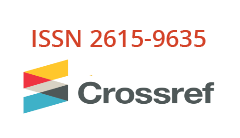References
[1] D. Molkdar, W. Featherstone, S. Lambotharan (2002). An overview of EGPRS: the packet data component of EDGE. J. Electron. Commun. Eng., 14(1),21–38.
[2] GSMA Intelligence (2014). Understanding 5G: Perspectives on future technological advancements in mobile. White paper.
[3] M. Agiwal and A. Roy and N. Saxena (2016). Next Generation 5G Wireless Networks: A Comprehensive Survey. IEEE Commun. Surveys Tuts., 18(3), 1617–1655.
[4] F. Akyildiz and W. y. Lee and M. C. Vuran and S. Mohanty (2008). A survey on spectrum management in cognitive radio networks. IEEE Commun. Mag., 46(4), 40–48.
[5] B. Wang and K. J. R. Liu (2011). Advances in cognitive radio networks: A survey. IEEE J. Sel. Topics Signal Process, 5(1), 5–23.
[6] M. Amjad and F. Akhtar and M. H. Rehmani and M. Reisslein and T. Umer (2017). Full-Duplex Communication in Cognitive Radio Networks: A Survey. IEEE Commun. Surveys Tuts, 19(4), 2158–2191.
[7] Z. Zhang and K. Long and A. V. Vasilakos and L. Hanzo (2016). Full-Duplex Wireless Communications: Challenges, Solutions, and Future Research Directions. Proc. of the IEEE, 104(7), 1369–1409.
[8] Asadi and Q. Wang and V. Mancuso (2014). A Survey on Device-toDevice Communication in Cellular Networks. IEEE Commun. Surveys Tuts., 16(4), 1801–1819.
[9] H. Q. Ngo and A. Ashikhmin and H. Yang and E. G. Larsson and T. L. Marzetta (2015). Cell-Free Massive MIMO: Uniformly great service for everyone. in Proc. Int. Workshop Signal Process. Adv. Wireless Commun., pp. 201–205.
[10] H. Q. Ngo and L. N. Tran and T. Q. Duong and M. Matthaiou and E. G. Larsson (2018). On the Total Energy Efficiency of Cell-Free Massive MIMO. IEEE Trans. Green Commun. Netw, 2(1), 25–39.
[11] H. Q. Ngo and A. Ashikhmin and H. Yang and E. G. Larsson and T. L. Marzetta (2017). Cell-Free Massive MIMO Versus Small Cells. IEEE Trans. Wireless Commun, 16(3), 1834–1850.
[12] H. Ju and E. Oh and D. Hong (2009). Improving efficiency of resource usage in two-hop full duplex relay systems based on resource sharing and interference cancellation. IEEE Trans. Wireless Commun., 8(8), 3933–3938.
[13] R. Lopez-Valcarce and E. Antonio-Rodriguez and C. Mosquera and F. Perez-Gonzalez (2012). An Adaptive Feedback Canceller for Full-Duplex Relays Based on Spectrum Shaping. IEEE J. Sel. Areas Commun, 30(8), 1566–1577.
[14] G. Interdonato and H. Q. Ngo and E. G. Larsson and P. Frenger (2016). How Much Do Downlink Pilots Improve Cell-Free Massive MIMO? IEEE Global Communications Conference (GLOBECOM), p.1–7.
[15] M. Bashar, K. Cumanan, A. G. Burr, H. Q. Ngo, and M. Debbah (2018). Cell-free Massive MIMO with limited backhaul, in Proc. IEEE ICC, pp. 1–7.
[16] S. Shamai and B. M. Zaidel (2001). Enhancing the cellular downlink capacity via co-processing at the transmitting end. in Proc. IEEE VTC-Spring, vol. 3, pp. 1745–1749.
[17] Osseiran, J. F. Monserrat, and P. Marsch (2016). 5G Mobile and Wireless Communications Technology. Cambridge University Press, ch. 9, Coordinated Multi-Point Transmission in 5G.
[18] Shidong Zhou and Ming Zhao and Xibin Xu and Jing Wang and Yan Yao (2003). Distributed wireless communication system: a new architecture for future public wireless access. IEEE Commun. Mag., 41(3), 108–113.
[19] J. Mitola and G. Q. Maguire (1999). Cognitive radio: making software radios more personal. IEEE Pers. Commun., 6(4), 13–18.
[20] G. I. Tsiropoulos and O. A. Dobre and M. H. Ahmed and K. E. Baddour (2016). Radio Resource Allocation Techniques for Efficient Spectrum Access in Cognitive Radio Networks. IEEE Commun. Surv. Tutor, 18(1), 824–847.
[21] Goldsmith and S. A. Jafar and I. Maric and S. Srinivasa (2009). Breaking Spectrum Gridlock With Cognitive Radios: An Information Theoretic Perspective. Proc. IEEE, 97(5), 894–914.
[22] V. Valenta and R. Marsˇalek and G. Baudoin and M. Villegas ´ and M. Suarez and F. Robert (2010). Survey on spectrum utilization in Europe: Measurements, analyses and observations. in Proc. 5th Int. Conf. CrownCom, Jun. 2010.
[23] S. Haykin (2005). Cognitive radio: brain-empowered wireless communications. IEEE J. Sel. Areas Commun., 23(2), 201–220.
[24] S. Srinivasa and S. A. Jafar (2007). Cognitive Radios for Dynamic Spectrum Access - The Throughput Potential of Cognitive Radio: A Theoretical Perspective. IEEE Commun. Mag., 45(5), 73–79.
[25] M. O. Hasna and M. S. Alouini (2003). End-to-end performance of transmission systems with relays over Rayleigh-fading channels. IEEE Trans. Wireless Commun., 2(6), 1126–113.
[26] S. Ikki and M. H. Ahmed (2007). Performance Analysis of Cooperative Diversity Wireless Networks over Nakagami-m Fading Channel. IEEE Commun. Lett., 11(4),334–336.
[27] H. A. Suraweera and H. K. Garg and A. Nallanathan, “Performance Analysis of Two Hop Amplify-and-Forward Systems with Interference at the Relay,” IEEE Commun. Lett., vol. 14, no. 8, pp. 692–694, Aug. 2010.
[28] J. H. Lee and O. S. Shin (2010). Full-duplex relay based on block diagonalisation in multiple-input multiple-output relay systems. IET Comm., 4(15), 1817–1826.
[29] J. N. Laneman and D. N. C. Tse and G. W. Wornell (2004). Cooperative diversity in wireless networks: Efficient protocols and outage behavior. IEEE Trans. Inf. Theory, 50(12), 3062–3080.
[30] T. Q. Duong and Vo Nguyen Quoc Bao and H. j. Zepernick (2009). On the performance of selection decode-and-forward relay networks over Nakagami-m fading channels. IEEE Commun. Lett., 13(3), 172–174.
[31] S. Yang and X. Xu and D. Alanis and S. Xin Ng and L. Hanzo (2016). Is the Low-Complexity Mobile-Relay-Aided FFR-DAS Capable of Outperforming the High-Complexity CoMP?. IEEE Trans. Veh. Technol., 65(4), 2154–2169.
[32] M. S. Pan and T. M. Lin and W. T. Chen (2015). An Enhanced Handover Scheme for Mobile Relays in LTE-A High-Speed Rail Networks. IEEE Trans. Veh. Technol., 64(2), 743–75.
[33] D. Hwang and D. I. Kim and S. K. Choi and T. J. Lee (2015). UE Relaying Cooperation Over D2D Uplink in Heterogeneous Cellular Networks. IEEE Trans. Commun., 63(12), 4784–4796.
[34] S. S. Nam and M. S. Alouini and S. Choi (2018). Iterative Relay Scheduling With Hybrid ARQ Under Multiple User Equipment (Type II) Relay Environments. IEEE Access, vol. 6, pp. 6455–6463.
[35] M. G. Khafagy, M. S. Alouini, and S. A¨ıssa (2018). Full-duplex relay selection in cognitive underlay networks. IEEE Trans. Commun., pp. 1–1.
[36] D. Feng and L. Lu and Y. Yuan-Wu and G. Y. Li and S. Li and G. Feng (2014). Device-to-device communications in cellular networks. IEEE Commun. Mag., 52(4), 49–5.
[37] F. Jameel and Z. Hamid and F. Jabeen and S. Zeadally and M. A.Javed (2018). A Survey of Device-to-Device Communications: Research Issues and Challenges. IEEE Commun. Surveys Tuts., pp. 1–1,.
[38] S. Sudevalayam and P. Kulkarni (2011). Energy Harvesting Sensor Nodes: Survey and Implications. IEEE Commun. Surveys Tuts., 13(3), 443–461.
[39] R. V. Prasad and S. Devasenapathy and V. S. Rao and J. Vazifehdan (2014). Reincarnation in the Ambiance: Devices and Networks with Energy Harvesting. IEEE Commun. Surveys Tuts., 16(1), 195–213.


















